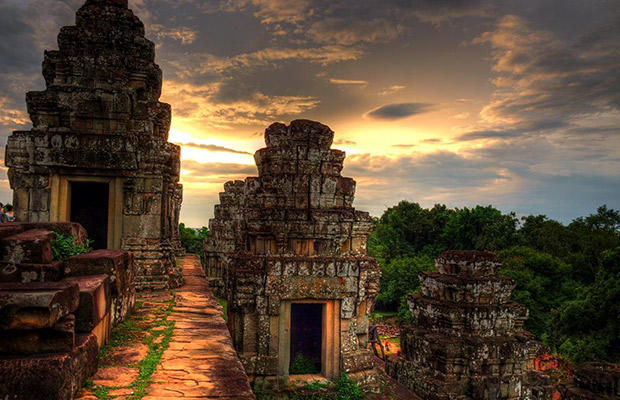
Phnom Bakheng is located 1,30 meters (4,265 feet) north of Angkor Wat and 400 meters (1,312 feet) south of Angkor Thom.
Enter and leave Phnom Bakheng by climbing a long steep path with some steps on the east side of the monument (height 67 meters, 220 feet) In the 1960 this summit was approached by elephant and, according to a French visitor, the ascent was “a promenade classic and very agreeable
Arrive at the summit just before sunset for a panoramic view of Angkor and its environs. The golden hues of the setting sun on this vista are a memorable sight. When Frenchman Henri Mouhot stood at this point in 1859 he wrote in his diary: ‘Steps.. lead to the top of the mountain, whence is to be enjoyed a view so beautiful and extensive, that it is not surprising that these people , who have shown so much taste in their buildings, should have chosen it for a site.
It is possible to see: the five towers of Angkor Wat in the west, Phnom Krom to the southwest near the Grand Lake, Phnom Bok in the northeast, Phnom Kulen in the east, and the West Baray.
Phnom Bakheng was built in late ninth to early tenth century by King Yasovarman dedicated to Siva (Hindi).
Phnom Bakheng is a temple mountain in honor of the Hindu god Shiva and one of the oldest temples in the Angkor Archaeological Park. Thanks to its location on a 60-meter high hill, Phnom Bakheng became a very popular tourist spot for its magnificent sunset views over Angkor Wat.
During his reign, King Jasovarman I (889 – 910 CE) moved the capital of his empire from Roluos to the location which is now known as Angkor. Here, he created an enormous city of 16 square kilometers; bigger than Angkor Thom, which was built later. In the center of this city, King Jasovarman built his State Temple on top of a natural hill, known as Phnom Bakheng hill.
Phnom Bakheng is a pyramid shaped temple consisting of 7 levels, symbolizing the sacred Mount Meru and the 7 Hindu heavens. 108 towers were arranged on the ground and upper levels of the temple, symbolizing the 4 lunar phases of each 27 days long. Unfortunately, most of these towers collapsed. The temple was devoted to the god Shiva and served as a tomb for king Jasovarman I.
Phnom Bakheng is located 400 meter south of Angkor Thom. If you’re approaching from Angkor Wat, then Phnom Bakheng hill is to the left side, set back from the road. It’s worth stopping. A sandy path winds up the hill to the foot of the temple. From here, steep and narrow stairs lead you to the top terrace. The view is breathtaking and if you visit at sunset it’s a soothing way to end the day.
Given that Phnom Bakheng’s main attraction is its sunset view over Angkor Wat, plan your visit for the late afternoon. Arrive early (4pm) if you want a good spot on the south-east corner. Especially in high season the temple can get crowded. Note that you’ll need a good zoom lens to make a close-up picture of Angkor Wat, which is 1.3km away. Alternatively, there’s a fantastic sunset view over West Baray on the opposite side (north-west corner).
After enjoying the sunset, be careful climbing down Phnom Bakheng temple’s steep steps. A small flashlight will come in handy.
The tiny 12th-century Buddhist temple of Neak Pean (sometimes written Neak Poan or Neak Poun sits on a circular stone island in a square pool, framed by four more pools, all built on an island in the middle of a lake. The temple’s name means “entwined serpents.”
A favorite Angkor sunset spot, Pre Rup is a 3-tier mountain temple topped with five sanctuary towers. Built in 961 AD as a temple to the Hindu god Shiva, Pre Rup’s name means “turn the body,” and some believe it was used for cremations. Its warm brickwork and red laterite stone look beautiful at sunrise or sunset.
The sprawling temple complex of Angkor Thom, an ancient Khmer capital formerly ringed by a crocodile-infested moat, surpasses the world-famous Angkor Wat in both size and scale. Each of the site’s five gates are heralded by avenues lined with 108 deities that represent good and evil, which provide spectacular photo opportunities before you even step inside.
The Siem Reap Art Center Night Market is open from morning until late in the evening, but it is more of a night market than an art center. Close to the Old Market (Phsar Chaa or Phsar Chas), the site boasts a wealth of stalls selling crafts, souvenirs, the obligatory elephant pants, and snacks.
© 2024, Angkor Discovery Tours. All Rights Reserved.
Our team of passionate guides are here would love to hear from you.

Phnom Bakheng Mountain Hill